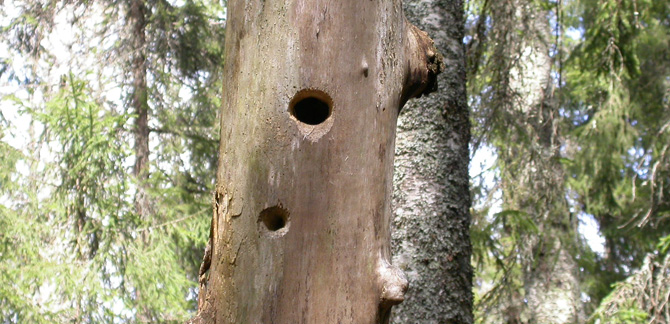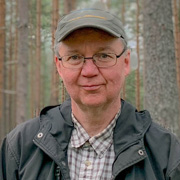Tree cavities – an indicator of forest biodiversity

Photo: Johanna Lakka
Tree cavities (holes) are used by birds for nesting, and form habitats for many other organisms. On an area of 170 km2 in southern Finland, tree cavities have been recorded for over 30 years. In a two-year project funded by Skogssällskapet, Finnish researchers will use this unique set of data to improve understanding of how tree cavities promote biodiversity.

Jari Kouki
“Since so much of the forest in Finland and Sweden is managed, it’s important to understand how we can also manage biodiversity in these forests,” says Jari Kouki, leader of the research project and professor in forest ecology at the University of Eastern Finland. “The areas currently under strict protection will not be enough to preserve biodiversity, so we need to learn more about how silviculture affects biodiversity.”
In recent years, scientists have come to understand the importance for biodiversity of small elements, microhabitats, such as individual trees or, as in this case, tree cavities, in the forest landscape. Not only do they provide nests for the birds that make them but, once vacated, many other bird species, so-called secondary breeders, nest there. The cavities are also important habitats for insects and fungi, and even for mammals such as squirrels, martens, and bats.
“We already know that birds make cavities in both living and dead trees and in all tree species, but some tree species, like aspen, are more preferred. We want to understand why some trees are more preferred than others and what role the cavities play over time for different organisms. We want to learn more about the occurrence of tree cavities – their size, how they were made, the trees in which they are found, how long they last, etc – and how they are affected by different silvicultural measures.
“Our aim is to find practical methods for counting and measuring cavities to assess biodiversity in an area. We want to create a standardised protocol for the classification of tree cavities that forest owners and field surveyors can use as one of several indicators for biodiversity. Joakim Hjältén, professor in animal ecology at the Swedish University of Agricultural Sciences (SLU), is involved in our project, and we hope that our results will be applicable in practical silviculture in both Finland and Sweden,” explains Jari Kouki.
Joint projects especially welcome
Skogssällskapet welcomes applications for funding from universities and research institutes in Sweden and Finland. Applications regarding joint projects, involving researchers from both countries, are especially welcome.
The first time Jari Kouki applied for funding from Skogssällskapet was in 2020.
“I first heard about Skogssällskapet and the research funding through an email forwarded to me by a colleague. The list of previously funded projects caught my interest when I realised that some of them were very close to our field of work.
“The two-step application process was excellent. The short text for the first application needs to be really well written to explain the project concept, but it doesn’t demand a lot of paperwork. And I really appreciated that the response came so quickly. The second step was also clear and straightforward, and especially the budget section was easy to understand and complete.
“I really like the idea of joint research projects involving several countries. Today there’s a lot of networking between researchers in Finland and Sweden, but it’s a bit surprising we don’t see more joint research projects, since conditions in the two countries are similar in so many ways. Very few funders actively promote joint research projects, so I think Skogssällskapet is playing a key role.”
